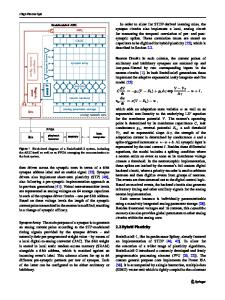Embedded System Design Modeling, Synthesis and Verification
Embedded System Design: Modeling, Synthesis and Verification introduces a model-based approach to system level design. It presents modeling techniques for both computation and communication at different levels of abstraction, such as specification, transa
- PDF / 4,360,508 Bytes
- 366 Pages / 439.37 x 666.142 pts Page_size
- 24 Downloads / 392 Views
Daniel D. Gajski • Samar Abdi Andreas Gerstlauer • Gunar Schirner
Embedded System Design Modeling, Synthesis and Verification
Daniel D. Gajski Center for Embedded Computer Systems University of California, Irvine 2010, AIR Bldg. Irvine, CA 92697-2620 USA [email protected]
Samar Abdi Center for Embedded Computer Systems University of California, Irvine 2010, AIR Bldg. Irvine, CA 92697-2620 USA [email protected]
Andreas Gerstlauer Department of Electrical & Computer Engineering University of Texas at Austin 1 University Station C0803 Austin, TX 78712 USA [email protected]
Gunar Schirner Center for Embedded Computer Systems University of California, Irvine 2010, AIR Bldg. Irvine, CA 92697-2620 USA [email protected]
ISBN 978-1-4419-0503-1 e-ISBN 978-1-4419-0504-8 DOI 10.1007/978-1-4419-0504-8 Springer Dordrecht Heidelberg London New York Library of Congress Control Number: 20099931042 © Springer Science+Business Media, LLC 2009 All rights reserved. This work may not be translated or copied in whole or in part without the written permission of the publisher (Springer Science+Business Media, LLC, 233 Spring Street, New York, NY 10013, USA), except for brief excerpts in connection with reviews or scholarly analysis. Use in connection with any form of information storage and retrieval, electronic adaptation, computer software, or by similar or dissimilar methodology now known or hereafter developed is forbidden. The use in this publication of trade names, trademarks, service marks, and similar terms, even if they are not identified as such, is not to be taken as an expression of opinion as to whether or not they are subject to proprietary rights.
Printed on acid-free paper Springer is part of Springer Science+Business Media (www.springer.com)
Preface
RATIONALE In the last twenty five years, design technology, and the EDA industry in particular, have been very successful, enjoying an exceptional growth that has been paralleled only by advances in semiconductor fabrication. Since the design problems at the lower levels of abstraction became humanly intractable and time consuming earlier then those at higher abstraction levels, researchers and the industry alike were forced to devote their attention first to problems such as circuit simulation, placement, routing and floorplanning. As these problems become more manageable, CAD tools for logic simulation and synthesis were developed successfully and introduced into the design process. As design complexities have grown and time-to-market have shrunk drastically, both industry and academia have begun to focus on levels of design that are even higher then layout and logic. Since higher levels of abstraction reduce by an order of magnitude the number of objects that a designer needs to consider, they have allowed industry to design and manufacture complex application-oriented integrated circuits in shorter periods of time. Following in the footsteps of logic synthesis, register-transfer and high-level synthesis have contributed to raising abstraction levels in the design m
Data Loading...











